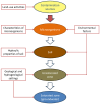Factors Influencing Microbial Contamination of Groundwater: A Systematic Review of Field-Scale Studies
- PMID: 38792743
- PMCID: PMC11124417
- DOI: 10.3390/microorganisms12050913
Factors Influencing Microbial Contamination of Groundwater: A Systematic Review of Field-Scale Studies
Abstract
Pathogenic microorganisms released onto the soil from point or diffuse sources represent a public health concern. They can be transported by rainwater that infiltrates into subsoil and reach the groundwater where they can survive for a long time and contaminate drinking water sources. As part of the SCA.Re.S. (Evaluation of Health Risk Related to the Discharge of Wastewater on the Soil) project, we reviewed a selection of field-scale studies that investigated the factors that influenced the fate of microorganisms that were transported from the ground surface to the groundwater. A total of 24 studies published between 2003 and 2022 were included in the review. These studies were selected from the PubMed and Web of Science databases. Microbial contamination of groundwater depends on complex interactions between human activities responsible for the release of contaminants onto the soil, and a range of environmental and biological factors, including the geological, hydraulic, and moisture characteristics of the media traversed by the water, and the characteristics and the viability of the microorganisms, which in turn depend on the environmental conditions and presence of predatory species. Enterococci appeared to be more resistant in the underground environment than thermotolerant coliforms and were suggested as a better indicator for detecting microbial contamination of groundwater.
Keywords: environmental factors; field studies; geological settings; groundwater; microbial contamination; public health.
Conflict of interest statement
The authors declare no conflicts of interest.
Figures



Similar articles
-
Sources, pathways, and relative risks of contaminants in surface water and groundwater: a perspective prepared for the Walkerton inquiry.J Toxicol Environ Health A. 2002 Jan 11;65(1):1-142. doi: 10.1080/152873902753338572. J Toxicol Environ Health A. 2002. PMID: 11809004 Review.
-
Planning Implications Related to Sterilization-Sensitive Science Investigations Associated with Mars Sample Return (MSR).Astrobiology. 2022 Jun;22(S1):S112-S164. doi: 10.1089/AST.2021.0113. Epub 2022 May 19. Astrobiology. 2022. PMID: 34904892
-
Combining stable isotopes with contamination indicators: A method for improved investigation of nitrate sources and dynamics in aquifers with mixed nitrogen inputs.Water Res. 2017 Nov 1;124:85-96. doi: 10.1016/j.watres.2017.07.041. Epub 2017 Jul 18. Water Res. 2017. PMID: 28750288
-
Study of the impact of land use and hydrogeological settings on the shallow groundwater quality in a peri-urban area of Kampala, Uganda.Sci Total Environ. 2007 Aug 1;381(1-3):180-99. doi: 10.1016/j.scitotenv.2007.03.035. Epub 2007 May 23. Sci Total Environ. 2007. PMID: 17512037
-
Groundwater fluoride contamination, probable release, and containment mechanisms: a review on Indian context.Environ Geochem Health. 2018 Dec;40(6):2259-2301. doi: 10.1007/s10653-018-0096-x. Epub 2018 Mar 23. Environ Geochem Health. 2018. PMID: 29572620 Review.
Cited by
-
Modeling solutions for microbial water contamination in the global south for public health protection.Front Microbiol. 2025 Apr 2;16:1504829. doi: 10.3389/fmicb.2025.1504829. eCollection 2025. Front Microbiol. 2025. PMID: 40241726 Free PMC article. Review.
-
Occurrence of Uncultured Legionella spp. in Treated Wastewater Effluent and Its Impact on Human Health (SCA.Re.S Project).Pathogens. 2024 Sep 12;13(9):786. doi: 10.3390/pathogens13090786. Pathogens. 2024. PMID: 39338977 Free PMC article.
-
Human health risk from groundwater consumption: A case study in the Apaaso-Tafo Community in the Bono East Region of Ghana.Heliyon. 2025 Feb 4;11(3):e42460. doi: 10.1016/j.heliyon.2025.e42460. eCollection 2025 Feb 15. Heliyon. 2025. PMID: 39995943 Free PMC article.
References
-
- World Health Organization. UNICEF. World Bank State of the World’s Drinking Water: An Urgent Call to Action to Accelerate Progress on Ensuring Safe Drinking Water for All. Geneva. [(accessed on 14 March 2024)]. Available online: https://iris.who.int/bitstream/handle/10665/363704/9789240060807-eng.pdf....
-
- United Nations World Water Assessment Programme/UN-Water . The United Nations World Water Development Report 2018: Nature-Based Solutions for Water. UNESCO; Paris, France: 2018. [(accessed on 14 March 2024)]. Available online: https://unesdoc.unesco.org/ark:/48223/pf0000261424.
-
- World Health Organization Burden of Disease Attributable to Unsafe Drinking-Water, Sanitation and Hygiene, 2019 Update. Geneva. [(accessed on 14 March 2024)]. Available online: https://iris.who.int/bitstream/handle/10665/370026/9789240075610-eng.pdf....
-
- Bagordo F., Migoni D., Grassi T., Serio F., Idolo A., Guido M., Zaccarelli N., Fanizzi F.P., De Donno A. Using the DPSIR framework to identify factors influencing the quality of groundwater in Grecìa Salentina (Puglia, Italy) Rend. Lincei. 2016;27:113–125. doi: 10.1007/s12210-015-0456-8. - DOI
-
- De Giglio O., Caggiano G., Bagordo F., Barbuti G., Brigida S., Lugoli F., Grassi T., La Rosa G., Lucentini L., Uricchio V.F., et al. Enteric viruses and fecal bacteria indicators to assess groundwater quality and suitability for irrigation. Int. J. Environ. Res. Public Health. 2017;14:558. doi: 10.3390/ijerph14060558. - DOI - PMC - PubMed
Publication types
Grants and funding
LinkOut - more resources
Full Text Sources
Research Materials

